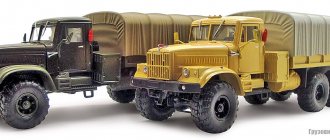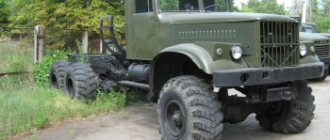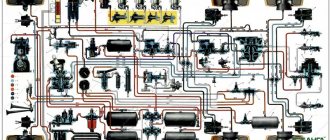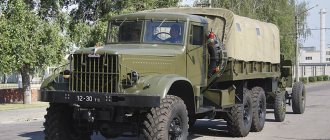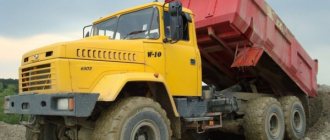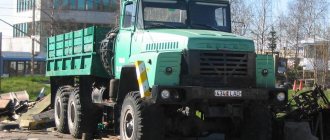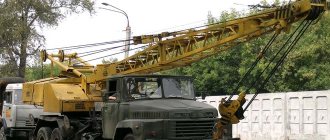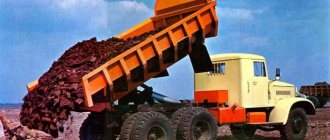Transitional model from the classic KrAZ to the modern KrAZ
KrAZ-250 is a Soviet three-axle heavy truck with two drive axles, which was produced from 1978 to 1992. This is a joint development of the Kremenchug Automobile Plant, HAMI and MBTU named after Bauman, which represents the evolutionary development of the most popular models of the plant - the KrAZ-219 and KrAZ-257 trucks. In turn, the KrAZ-250 became the founder of new families of Kremenchug trucks, the very transitional model on which their new corporate style and recognizable profile were developed.
Device. Similarities and differences between KrAZ-219 (-257) and KrAZ-250
In addition to a completely new cabin, the other main innovation of the KrAZ-250 was the 8-cylinder diesel engines of the YaMZ-238 family. Structurally, the KrAZ-250 was created on the basis and many components of the KrAZ-219/257. But it was made with updated units and using more modern technologies at that time. In particular, the axles and suspension were “inherited” from the 257th family. But the spar frame of the KrAZ-250 truck is made of thicker steel, 8 mm, with cross members and reinforcing elements. The frame features bolted connections that increase flexibility and strength under a variety of load combinations. Frame width – 860 mm.
The engine, as already indicated, was new. Several quite important changes were made to the truck's transmission. For example, the driveshaft began to pass through the middle bogie and be connected from the cab, from the transmission control panel. Such a solution contributed to the release of 350 kilograms of payload and made it possible to expand the capacity of the fuel system. On the KrAZ-250 it became possible to place two tanks with a capacity of 250 liters of diesel fuel and another one with a capacity of 50 liters of diesel fuel. This provides a power reserve of almost a thousand kilometers.
The cardan drive consists of two shafts with a sequential drive. Cardan shafts are tubular, open type. The diameter of the front shaft pipe is 114 mm, and the rear one is 89 mm. Rigid universal joints are mounted on needle bearings - the same as on KrA3-219/257. The front and rear axle housings are interchangeable. They are not cast, as on their predecessor trucks, but made from sheet steel using the stamping method.
Subsequently, when studying the operation of the KrA3-257, it was concluded that there was no need for a separate drive through 2 cardan shafts. Gradually we came to a less complex drive for the front and rear axles with a middle axle through passage, connected from the cab. The transmission control, in particular the axles, has become push-button rather than lever-based, as before. This simplified the ergonomics of the cabin and improved the workspace. The control panel was moved to the right side behind the pressure indicator area, since it was used infrequently.
The track and distance between the dual rear wheels of the KrAZ-250 have become slightly smaller than that of previous models. The tires were used with a narrower profile, and the track ended up being the same as that of the KrAZ-219. In the suspension, compared to Kra3-219/257, greater softness has been achieved - due to changing the profile of the sheets and installing springs of variable stiffness. The sliding of the ends of the springs on the linings of the rear axle beams has been reduced. Bronze bushings in the balancers were replaced with textolite bushings. The new steering mechanism has an increased efficiency. On the Kra3-219, a worm with a side sector was used as a working pair. And on the KrA3-250 a rolling pair was implemented: a single-thread screw and a nut with a semicircular threading profile. Instead of pneumatic power steering, hydraulic power steering is used.
Compared to its predecessor, the 250 is more advanced in its design and has better performance. Payload has increased from 13.2 tons to 14,575 tons, and top speed has increased from 68 km/h to 75 km/h. The control diesel fuel consumption of the KrA3-250 is less than 3 liters/100 km. KrAZ-250 requires less time and labor costs for its maintenance. The labor intensity of maintenance, in statistical terms, per 1000 kilometers, was reduced from 2.58 to 1.87 man-hours. The standard service life before the 1st overhaul is 200 thousand kilometers (for the 1st category of operating conditions). Since the layout is more modern and rational, it was possible to significantly shorten the car’s engine hood, and this greatly improved visibility, reducing the part of the road invisible to the driver.
A tubular-ribbon cooling radiator is used, which is more durable compared to the previous tubular-plate radiator. The electrical equipment system as a whole has remained without major changes - it is single-wire, with a rated voltage of 24V. However, the lighting technology was brought into compliance with UNECE standards: the headlights moved to the bumper, and the turn indicators to the wings, that is, they “swapped places.” To inform the driver, new light indicators were introduced: high beam headlights, car turns, reduction of air pressure in the pneumatic system receivers, minimum oil pressure in the engine and overheating of the coolant. Instead of four 6STE-128 batteries, two 6STEN-140M batteries were used.
Design changes were also made to the truck chassis components. In particular, a hydropneumatic device was used in the clutch drive, and a pneumatic amplifier was used to disable it. As a result, the force required for the clutch pedal has been reduced by four times. In the 2-speed transfer case, the top gear ratio was increased from 1.00 to 1.23. Thanks to this, it was possible to increase the maximum speed of the car. Compared to the KrAZ-219, the KrA3-250 has smaller dimensions and weighs 925 kg less; and the carrying capacity is greater.
Thus, the new KrAZ differed from the classic trucks of this brand in a number of new and improved components and assemblies. And, above all, what is noticeable at first glance is its appearance: a completely different cabin, tail, and hood. The KrAZ-250 cabin still cannot be called comfortable for work. But still it is much more comfortable than the KrAZ-219/257.
Device
The front suspension of the model is installed on semi-elliptical springs equipped with shock absorbers, the rear suspension is on two semi-elliptical springs, supplemented by reaction bars. The front axle of the model is unified with the MAZ-500A axle.
The main braking system consists of a 2-circuit pneumatic drive and drum mechanisms. The system operates on all wheels. The first drive circuit ensures the functioning of the brakes on the intermediate and front axles, the second circuit is designed for the rear axle. Increased reliability is guaranteed by parking and spare brakes, which also improve the technical parameters of the model. The described system contains an alcohol-type fuse and a moisture separator that prevent condensate from freezing. They optimize the operation of the functional unit, allowing you not to worry about its reliability even in severe frosts.
The car has discless wheels, similar to those used on MAZ products. Typically the model is equipped with radial tires.
The steering mechanism is represented by a screw with a ball rack and is equipped with a hydraulic booster, making it easier to turn. Thanks to the additional tank, the car's power reserve was significantly increased.
The KrAZ-250 is equipped with a mechanical cabin designed for two passengers and a driver. The driver's seat is adjustable to suit individual weight and height. The comfort of this element is ensured by:
- blowing warm air across windows;
- rear view mirrors;
- radio;
- heating systems;
- windshield cleaning mechanism;
- fan, rotating windows and lowering windows;
- visors protecting from the sun;
- compartment for documents.
The instrument panel of the car includes warning indicators about changes in pressure in the receivers, overheating of the coolant, the maximum amount of oil level in the power unit and switching the high beams. The cabin itself and the empennage are attached to the chassis at 4 points, forming a single structural unit.
One of the most popular modifications of the KrAZ-250 is the crane installation. It has good maneuverability and allows you to move the unit to the desired point on the construction site. The lifting mechanism is located on a movable platform, and the boom is equipped with load grips and steel ropes. The maximum lifting level of the boom is 10.3 m, the maximum lowering depth is 4.4 m.
Due to its technical parameters, the KrAZ-250 is still actively used today. There are quite a few centers in Russia that carry out maintenance of this vehicle, so repairs and replacement of components will not be a particular problem. The machine, which has already earned the reputation of being a hardy and durable technology, will last for decades if handled properly.
Dimensions:
- length – 9640 mm;
- width – 2650 mm;
- height – 2620 mm;
- wheelbase – 5050 (+1400) mm;
- ground clearance - 290 mm;
- front track – 1920 mm;
- rear track – 1950 mm;
- turning radius – 10500 mm.
Car drawing
Drawing of KrAZ-250
Cabin
The metal cabin is designed for a driver and two passengers. The driver's seat is adjustable according to individual height and weight.
The comfort of this element of the truck consists of the following parameters:
- heating system ;
- blowing the windows with a stream of warm air;
- mechanism for windshields ;
- rear view mirrors;
- fan , roll-down windows, rotating windows;
- the presence of a radio receiver, a compartment for documents, sun visors .
The car control panel contains indicators that inform the driver about switching high beams, changes in pressure in the pneumatic system receivers, engine oil level, and overheating of the cooling fluid.
The cab and tail of the truck are secured to the chassis in 4 places, allowing these elements to be separated into a separate structural unit.
The maximum speed developed by the car is 75 km/h.
Important! The volume of fuel tanks is measured at 330 liters (2 tanks of 165 liters each). Fuel consumption – 35 l per 100 km/h at a speed of 60 km/h.
The weight of the equipped KrAZ-250 (with a shortened frame) is 9,050 kg, and its load capacity is 14,575 kg.
The dimensional parameters of the described truck consist of the following technical characteristics:
- length – 9,520 mm;
- width – 2,500 mm;
- height – 2,695 mm.
With a ground clearance of 275 mm, the overall turning radius of the vehicle is 13 m, the maximum climbability is 35%, which are very good characteristics of maneuverability and mobility for a representative of special equipment of this kind.
Thus, the KS-4562 truck crane based on the KrAZ-250 chassis has all the advantages of the mentioned basic model, which allow the use of this type of special equipment for high-performance work, regardless of external conditions.
Clutch repair, maintenance and replacement
Every time you start maintenance of the clutch, you must adhere to a strict sequence so as not to miss anything important and notice the problem in time:
- The first step is to check and, if necessary, adjust the free play of the clutch responsible for engaging the clutch (the gap should be 3.2–4 mm).
- Next, you need to check the mechanism for lack of guidance. (check is carried out with the engine running in first gear and with the clutch disengaged).
If you find out that the value is far from the maximum norm, there is only one way out, adjusting the YaMZ 238 transmission.
- The adjustment should begin by measuring the free play of the clutch pedal. For YaMZ 238 it should be from 34 to 43 mm. The value should be checked using a ruler, after bleeding air from the pneumatic system in advance. So, if something is not right, we proceed to adjustment. However, first make sure that the gap between the end of the rear cover of the valve body and the retaining ring is within the normal range - 3.5+0.2 mm. If necessary, adjust it too.
- Next, it is necessary to adjust the gap from the second driven disk to the thrust ring of the retraction arms. (it should be within 64 mm).
- Next, we adjust the gap using the thrust ring and the clutch bearing to engage the YaMZ 238 mechanism. Here the values fluctuate within 3.6 mm. Please note that complete absence of this clearance can lead to failure of the thrust bearing and malfunction of the driven disk.
If the measures taken do not help, and the clutch malfunction persists, most likely, adjustment is not a panacea and the mechanism will need to be replaced.
First of all, in order to independently replace the YaMZ 238 clutch with a new one, you need specific skills and at least one assistant. If all this is available, then most likely there will be no serious problems. Let's get started:
- First you will have to remove the gearbox, this is necessary to get to the flywheel and clutch housing.
- Next, unscrew the fastenings of the casing to the flywheel and remove the release disk.
- We unscrew the automatic adjustment bars for the stroke of the middle disk and remove the split rings from the rod.
- Remove the driven, middle, first driven and driving clutch discs.
About the history of KrAZ-250
During operation, including in areas with extreme climatic conditions, the KrAZ-257 proved to be a reliable, unpretentious and fairly high-quality vehicle, but already in the 60s it became obvious that these trucks could not meet the basic requirements of decent conditions drivers' labor. However, due to their cheapness and well-established production, they continued to be produced for many more years. And plans to transition the plant to mass production of the modernized KrAZ-250 family were constantly postponed to the future.
The development of a new promising family of heavy trucks began back when KrAZ was YaAZ: at the Yaroslavl Automobile Plant, in the 1950s. Along with the transfer of all truck production from Yaroslavl to Kremenchug, plans for the creation of a new 250th family of heavy trucks were transferred in 1958. But they were implemented very, very slowly.
The photo of a prototype of the KrAZ-250, taken in 1961, clearly shows that it was an attempt to install on the vehicle a cabin unified with the ZIL-130 (which went into mass production in 1964). However, in the end, the 250th model received a completely different design and its own cabin.
The article says that a 240-horsepower YaMZ-238 diesel engine was installed on experimental cars of these models. Subsequently, it was replaced by its turbocharged version - YaMZ-238D, with a power of 330 hp, testing and development of which were completed by the end of the 60s. A new 9-speed gearbox with changed gear ratios was also made for it.
The fine-tuning and launch of the car into production dragged on for many years. The plant continued mass production of cheaper and less technologically advanced 257 series trucks and their modifications. And the new model turned out to contain many solutions and technologies that had not yet been mastered by Soviet industry. Therefore, in production it turned out to be 2-2.5 times more expensive, and it took twice as long to assemble each machine. The national economy needed a lot of heavy trucks, and the Kremenchug Automobile Plant continued to fulfill the plan, “stamping” inexpensive to produce and technologically well-adjusted vehicles of the KrA3-157 family. And he put off the new family “for later.”
As a result, when in 1978 the KrA3-250 and the army KrAZ-260 finally entered the factory assembly line, the automotive industry and life itself had moved so far forward that these new models initially turned out to be outdated, requiring modernization. More than eighty percent of the parts of the 250th and 260th KrA3ov were unified. And the front axle, discless wheels and radial tires of the 250 were unified with the MA3-500A.
In total, over the years of production, about 17 thousand KrA3-250 vehicles were produced. On the scale of the Soviet Union, this is not much. Produced in small quantities until 1993, when these KrAZ trucks were replaced by new models: KrA3-6505, 6510; KrA3-6510 and KrAZ-6443 dump trucks also became successors to the 250th family, unified with it in terms of main components and assemblies.
Purpose
The KrAZ-250 is a modification of the KrAZ-257B1A truck, the production of which never ceased even after the launch of the restyled model. The differences affected not only the exterior (refreshed both inside and outside the cabin, shorter hood), but also in almost all standards, such as fuel consumption and increased mileage to 1 maintenance.
Our guest, unlike the previous model, has improved efficiency, acceptable speed performance and a sufficient level of comfort for the driver. But among the traditional qualities of cars produced by the enterprise in Kremenchug are ease of use, endurance and reliability, which is exactly what the 250th brand has.
The KrAZ-250 can operate not only on roadways where there is a hard surface, but also where there are even dirt roads. Moreover, the car can be operated in different temperature conditions, from -40 to +40 degrees Celsius. This has made it an indispensable model that helps in geographical areas where different climatic conditions are present.
Options and modifications
- KrA3-250 is a basic model, an “empty” chassis for add-ons, or a chassis with an onboard platform.
- KrA3-250V – truck tractor.
- KrA3-250K is a special crane chassis for mounting truck cranes produced by the Drogobych and Kamyshin truck crane plants.
- KrA3-251 – 14-ton dump truck with rear unloading.
- KrA3-252 – truck tractor.
“Empty” KrAZ-250 chassis were sent to specialized factories, where, in addition to cranes, they were also equipped with concrete mixers, concrete pumps, cranes and other special-purpose equipment. But the most common option was a truck crane, with a maximum lifting capacity of 20 tons and a maximum lifting height of the boom of 10.3 m. The lifting device is located on a movable platform, and the boom is equipped with steel ropes and load grippers. The design includes outrigger supports that provide auxiliary stability during manipulations with the load.
KrA3-260 all-wheel drive trucks performed the tasks previously assigned to the KrA3-255 family. The main ones in this family are the KrA3-260D truck tractor and the KrA3-260 flatbed tractor. They were intended, for example, to tow heavy 152 mm guns. Truck tractors towed semi-trailers with armored vehicles and low-bed semi-trailers of the S-3OOPTS anti-aircraft missile system. Various engineering vehicles were mounted on the chassis: PPS-64 and PPS-91 parks, E0V-4422 excavators, TMM-ZM bridge, UMS-2B bridge-building installations, etc.
All modifications of KrA3-25O are designed for roads allowing a load of 18 tons on dual rear axles, and can operate at temperatures from +40° to –40°. The KrA3-25O vehicle can tow a trailer weighing up to 20 tons. The car is designed in such a way as to ensure the highest possible unification both within the family and with previous cars of the Kremenchug Automobile Plant.
Advantages and disadvantages
According to reviews of people who have used the KrAZ-250, it has the following negative aspects:
- Low level of comfort by modern standards.
- Heavy weight and fuel consumption.
- Slow speed.
- Noisy.
But there are also certain positive qualities:
- Ease of use.
- High reliability.
- Torque and load capacity.
- High cross-country ability.
KrAZ-250 engine
Cars of this model were equipped with eight-cylinder V-shaped diesel engines YaMZ-238, YaMZ-238D, YaMZ-238M2. The working volume of this engine is 14.86 liters, the compression ratio is 16.5, the cylinder operating order is 1-5-4-2-6-3-7-8. The cylinder diameter is 13O mm, the piston stroke is 14O mm. 14.86 l, compression ratio 16.5, operating order 1-5-4-2-6-3-7-8. The rated power of the naturally aspirated modification is 176 kW (24О hp), with turbocharging – 243 kW (33О hp), at 21Оо rpm, torque 883 Nm (90 kgf-m) at 1250-1450 rpm The high-pressure fuel pump is an 8-section, spool-type, with a low-pressure fuel priming pump, a diesel fuel injection advance clutch and an all-mode speed controller. Nozzles are closed type. Dry air filter, with replaceable filter element and clogging indicator. The engine was equipped with a PZhD-44MBU pre-heater with a heat output of 32,000 kcal/h.
Chassis load capacity, kg: with regular frame 14575 with shortened frame 14725
Load capacity of chassis with platform (vehicle), kg 13300
Weight of the equipped chassis, kg: with a regular frame 9200 with a shortened frame 9050
Including: on the front axle: with a regular frame 4580 with a shortened frame 4550
on a trolley: with a regular frame 4620 with a shortened frame 4500
| Gross chassis (vehicle) weight, kg 24,000 Including: front axle 6,000 bogie 18,000 Permissible trailer weight, kg 20000 Max. vehicle speed, km/h 75 Vehicle acceleration time to 60 km/h 60 Vehicle run-out from 50 km/h, m 700 Max. climbability of the car, % 35 Braking distance of the car from 40 km/h, m 17.2 Control fuel consumption of the car, at a speed of 60 km/h, l/100 km 35 Turning radius, m: along the outer wheel 12 overall 13 |
Engine.
Maud. YaMZ-238M2, diesel, V-o6p.(90°), 8-cyl, 130x140 mm, 14.86 l, compression ratio 16.5, operating order 1-5-4-2-6-3-7-8 , power 176 kW (240 hp) at 2100 rpm, torque 883 Nm (90 kgf-m) at 1250-1450 rpm. The fuel injection pump is eight-section, spool-type, with a low-pressure fuel priming pump, a fuel injection advance clutch and an all-mode speed controller. The nozzles are closed type. The air filter is dry with a replaceable filter element and a clogging indicator. The engine is equipped with a PZhD-44MBU pre-heater with a heating capacity of 32,000 kcal/h.
Transmission.
Clutch model YaMZ-238, double-disc, with peripheral springs, release drive - mechanical. Gearbox - mod. YaMZ-2 36N, 5-speed, with synchronizers in II, III, IV and V gears, gear. numbers: I-5.26; II-2.90; III-1.52; IV-1.00; V-0.66; ZX-5.48. The transfer case is 2-speed, with a center differential lock. Transfer case gear shifting is mechanical, differential lock engagement is pneumatic, gear. numbers - highest gear - 1.23, low - 2.28. There are three cardan drives: gearbox - transfer case; transfer case - middle axle, transfer case - rear axle (two cardan shafts with an intermediate support). The main gear of the drive axles is double with bevel spiral and cylindrical spur gears. Send number 8.21.
Wheels and tires.
Wheels - discless, rim 8.5V-20, fastening - 6 bolts with clamps. Tires 11.00R20 (300R508) mod. I-68A, air pressure in the front tires is 7.5, bogies - 6.0 kgf/cm. sq. Number of wheels 10+1.
Suspension.
The front one is mounted on two semi-elliptic springs with shock absorbers, the ends of the main sheets are installed in rubber cushions of the support brackets; the rear is balanced, on two semi-elliptic springs, with six reaction rods, the ends of the springs are sliding.
Brakes.
Service brake system - with drum mechanisms (front - diameter 420, lining width 100 mm; rear - diameter 440, lining width 140 mm, cam release), dual-circuit pneumatic drive (one circuit for the front and middle axles, the second - for the rear axle ). The parking brake is a transmission, drum, mechanically driven, installed on the output shaft of the transfer case, acts on the rear axle. The spare brake is one of the circuits of the service brake system. The auxiliary brake is a motor retarder with a pneumatic drive. The trailer brake drive is combined (two- and single-drive). There is a moisture separator with thermodynamic purification of compressed air from moisture and an alcohol fuse against condensate freezing.
Steering.
The steering mechanism is a screw and a ball nut-rack that meshes with the gear sector. The hydraulic booster acts on the longitudinal steering rod and consists of a power cylinder and a distributor. Send steering gear number 23.6. Oil pressure in the amplifier is up to 70 kgf/cm. sq.
Electrical equipment.
Voltage 24 V, ac. battery 6ST-1 82 (2 pcs.), generator G288-E with voltage regulator 1112.3702, starter 25.3708-01 or ST103A-01.
Filling volumes and recommended operating materials.
Fuel tanks - 2×165 l. diz. fuel; cooling system with heater - 48l, water, antifreeze A-40 or A-65; engine lubrication system - 32l, at temperatures above +5°C - M-10V2, at temperatures below +5°C - M-8V2; gearbox - 5.5 l, TSp-15K, at temperatures below minus 30°C, a mixture of 85% TSp-15K and 15% diesel fuel A or Z; transfer case - 11l, TSp-15K (replacement - TAp-15V), at temperatures below minus 25°C - TSp-10 (replacement - a mixture of 85% TAp-15V or TSp-15K and 15% diesel fuel A or Z) ; crankcases of the middle and rear axles 2×12 l, TAp-15V (replacement - TSp-15K), at temperatures below minus 25 ° C - TSp-10 (replacement mixture of 85% TSp-15K or TAp-1 5V and 1 5% diesel fuel A or 3); steering gear housing - 1 2.25 l, oils for drive axle housings; power steering - 3.9 l, grade P oil (substitute - AU oil), in summer - I20A oil, at temperatures below minus 25°C - VMGZ; shock absorbers - 2×0.85 l, shock absorbing fluid AZh-12T (substitute - AU oil); fuse against condensate freezing in brakes - 0.18 l, technical ethyl alcohol.
Weight of units
(in kg). Engine with clutch and gearbox -1600; transfer case - 330; front axle - 410; rear and middle axles - 850 kg each; frame - 986; cockpit with tail - 550; front spring - 99; rear spring - 140; radiator with curtain - 58; wheel with tire - 120.
Transmission
Clutch 2-disc, with peripheral springs and mechanical drive. The gearbox is 5-speed, 3-way, with synchronizers in 2nd, 3rd, 4th and 5th gears. The transfer case is 2-speed, with an inter-axle lockable differential. Transfer case gear shifts are mechanical, differential lock engagement is pneumatic, gear. numbers - in top gear - 1.23; at the lowest - 2.28. In stock 3 cardan transmissions: gearbox - transfer case; transfer case - middle axle, transfer case - rear axle (2 cardan shafts with intermediate support). The main gear of the drive axles is double, with bevel spiral and cylindrical spur gears. Send number 8.2 I.
Engine
The truck is equipped with a V-shaped diesel power unit YaMZ-238M2, which has 8 cylinders. Maximum power – 240 hp. s., which is achieved at 2100 rpm. Using a double-disc dry clutch, the engine is coupled to a five-speed manual transmission. Effective engine cooling is provided by a tubular-band radiator.
Excellent speed characteristics were achieved through the installation of a transfer case with two stages and a center differential.
Steering and brake control
The steering mechanism is made according to the principle of “screw and ball nut-rack”, which meshes with the gear sector. The hydraulic booster acts on the longitudinal steering rod. It consists of a power cylinder and a distributor. The steering gear ratio is 23.6. Oil pressure in the hydraulic booster is up to 70 kgf/cm. sq.
The working brake system is a 2-circuit pneumatic drive and drum mechanisms on all wheels. The first circuit guarantees the operation of the brakes on the front and intermediate axles, and the second circuit is intended for the rear axle. Increased reliability is ensured by transmission parking and spare brakes. There is an alcohol-type fuse and a moisture separator that prevent condensate from freezing.
In the front drum mechanisms, the diameter is 42О mm, the width of the linings is 1ОО mm; in the rear - diameter 44О mm, width of linings 14О mm. Cam release. The auxiliary brake is a motor retarder with a pneumatic drive.
Technical specifications in numbers
- Chassis load capacity – 14.575 t (conventional frame); 14.725 (short frame).
- The carrying capacity of the machine with an onboard loading platform is 13.3 tons.
- Curb chassis weight – 9.2 t (conventional frame); 9.05 t (short frame).
- Front axle load – 4.58 t (regular frame); 4.55 t (short frame).
- Load on the trolley – 4.62 t (regular frame); 4.5 t (short frame).
- The total weight of the vehicle is 24 tons, including 6 tons on the front axle and 18 tons on the rear bogie.
- The permissible trailer weight is 20 tons.
- The dimensions of the onboard cargo platform are 5.77 m × 2.45 m.
- The highest speed of the car is 75 km/h.
- The greatest climb to overcome is 35%.
- The control diesel fuel consumption of a car, at 60 km/h, is 35 l/100 km.
- The capacity of the fuel tanks, in the final version of the vehicle - two of 165 liters each. The turning radius is 12 m on the outer wheel, 13 m on the overall wheel.
- Length – 9.52 m; width – 2.5 m; height – 2.695 m.
- The wheelbase is 4.88 m from the front axle to the intermediate axle axis and 1.4 m at the rear bogie.
- The track is 1.87 m for the front wheels and 1.833 m for the rear wheels.
- Loading height – 1.08 m.
- Ground clearance – 275 mm.
Pros of the car
- Good maneuverability;
- Good ride height;
- There are no problems with purchasing spare parts and components;
- Good maintainability;
- Relatively low cost of the car (compared to European analogues);
- Powerful power unit;
- Good load capacity;
- Often used as special equipment, in the form of a truck crane;
- Convenient machine platform;
- The presence of two rear drive axles;
- Can work in different climatic conditions;
- Not afraid of dust and dirt;
- Clear controls;
- There is a hydraulic power steering wheel;
- The driver's seat can be adjusted mechanically;
- Not afraid of overloads;
- Lots of free space in the cabin;
- Powerful look.
Cabin of KrAZ-250
The appearance of the KrA3-25O cabin was regularly modernized, but these transformations were not drastic. The interior of the car remained virtually unchanged, maintaining its appearance from the 1978 model. And even earlier. The already mentioned deputy. Head of the Design Bureau of the Kremenchug Automobile Plant N. Chistov in the February 1962 issue of “Behind the Wheel” notes that when creating the KrA3-250, special attention was paid to improving the work of drivers. The cabin at shoulder level is 1.83 m wide, thanks to which even three men of heavy build and in winter clothes will feel free in it.
The driver has a separate seat with adjustments for height, length and backrest angle. In winter, the cabin interior is quickly and efficiently heated, the windows (and side windows) are blown with streams of warm air. The windshield is wide, panoramic, divided into two parts. The hood (equipped with a spring balancing mechanism for easy lifting) is significantly reduced, and visibility is expanded.
Cost of a used KrAZ-250 vehicle
Despite their advanced age, used KrAZ-250 vehicles in working condition are available on the secondary market. Including concrete mixers and truck cranes. The price range is from 200 to 500 thousand rubles.
In the second issue of the magazine “Behind the Wheel” for 1962, Deputy. Head of the Design Bureau of the Kremenchug Automobile Plant N. Chistov says that in the future the enterprise has a qualitatively new family of more advanced, productive, convenient and comfortable cars: KrA3-250 - the basic model (chassis and flatbed truck), KrA3-251 (dump truck) and KrA3-252 (tractor tractor). The military all-wheel drive version of the 6x6 chassis - Kra3-260 - will be added to this list later.
The wheels are discless type, with 8.5B-2O rims, secured with six bolts with clamps. Tires size 11.00R20 (300R508) mod. I-68A, with set air pressure: in the front tires 7.5, in the tires of the rear bogie - 6.0 kgf/cm. sq. The number of wheels is 1O+I. The weight of each wheel with tire is 120 kg.
Suspension and chassis of the KrAZ-250
The truck's dependent front suspension is mounted on longitudinal semi-elliptic springs and equipped with telescopic shock absorbers, and the balanced rear suspension is mounted on two semi-elliptic springs and equipped with reaction bars.
The wheels are discless type, with 8.5B-2O rims, secured with six bolts with clamps. Tires size 11.00R20 (300R508) mod. I-68A, with set air pressure: in the front tires 7.5, in the tires of the rear bogie - 6.0 kgf/cm. sq. The number of wheels is 1O+I. The weight of each wheel with tire is 120 kg.


